

Kimberley
Elearning models. Digital literacy. Family tree. IMPLEMENTING THE SEVEN PRINCIPLES - Chickering and Ehrmann. For more teaching ideas, workshop materials and evaluation ideas, go to IMPLEMENTING THE SEVEN PRINCIPLES: Technology as Lever by Arthur W.
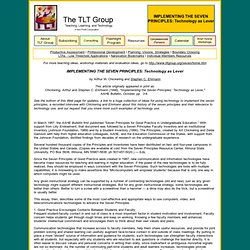
Chickering and Stephen C. Ehrmann This article originally appeared in print as: Chickering, Arthur and Stephen C. See the bottom of this Web page for updates, a link to a huge collection of ideas for using technology to implement the seven principles, a recorded interview with Chickering and Ehrmann about this history of the seven principles and their relevance to technology use, and our request that you share more such examples of technology use. In March 1987, the AAHE Bulletin first published “Seven Principles for Good Practice in Undergraduate Education.” Several hundred thousand copies of the Principles and Inventories have been distributed on two- and four-year campuses in the United States and Canada. 1.
The biggest success story in this realm has been that of time-delayed (asynchronous) communication. 2. 3. 4. 5. 6. 7. Stephen C. Ncltitpack.ncdpi.wikispaces. Educators who exhibit best practices with technology are creative, flexible, and adapt in ways which enable them to navigate the constraints, affordances, and interactions within TPACK framework.
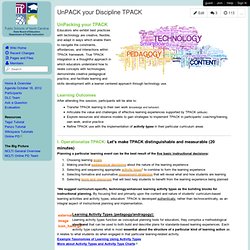
True TPACK integration is a thoughtful approach in which educators understand how to relate concepts with technologies, demonstrate creative pedagogical practice, and facilitate learning and skills development with a learner centered approach through technology use. Learning Outcomes After attending this session, participants will be able to:Transfer TPACK learning to their own work (knowledge and behavior)Articulate the value and challenges of effective learning experiences supported by TPACK (attitude)Explore resources and observe models to gain strategies to implement TPACK in participants’ coaching/training, own work, and/or practiceRefine TPACK use with the implementation of activity types in their particular curriculum areas I. Learning Activity Types (pedagogy/andragogy): II. III. Using the TPACK Image. Personas. Personas are a tool for sharing our understanding of our expected users, as a starting point for design.Whether we are designing a jet plane or a learning activity, we are ultimately designing it for people – pilots and passengers in the first case, teachers and learners in the second.
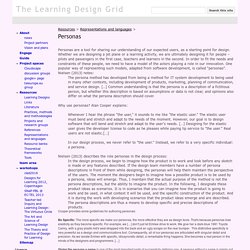
In order to fit the needs and constraints of these people, we need to have a model of the actors playing a role in our innovation. One popular way of representing such models, adapted from software development, is called “personas”. Nielsen (2013) notes: The persona method has developed from being a method for IT system development to being used in many other contexts, including development of products, marketing, planning of communication, and service design. [..] Common understanding is that the persona is a description of a fictitious person, but whether this description is based on assumptions or data is not clear, and opinions also differ on what the persona description should cover. Why use personas? Instructional design as an art and a science. Instructional Development Timeline. Online Student Experience. Whose really at the wheel on the journey of. What’s the Difference Between “Using Technology” and “Technology Integration”?
Education design. May10. 10 design principles for creating engaging online team work. Online collaboration. The Collaboration Pyramid by oscarberg, on Flickr The Collaboration Pyramid offers a great visual to dive deeper into the nature of authentic collaboration and optimized production.
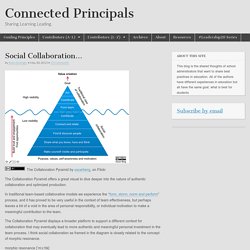
In traditional team-based collaborative models we experience the “form, storm, norm and perform” process, and it has proved to be very useful in the context of team effectiveness, but perhaps leaves a bit of a void in the area of personal responsibility, or individual motivation to make a meaningful contribution to the team. The Collaboration Pyramid displays a broader platform to support a different context for collaboration that may eventually lead to more authentic and meaningful personal investment in the team process. I think social collaboration as framed in the diagram is closely related to the concept of morphic resonance. morphic resonance [ˈmɔːfɪk] n.
Rethink pedagogy? Why? Effective Practice in a Digital Age. Daskim. Daskim. Using Mobile Web 2.0 to Transform Pedagogy and Engage Learners. Author Thomas Cochrane, Unitec New Zealand Using a community of practice approach to explore the potential of technology to enhance tertiary education, mobile learning trials were established within design, music and landscape courses at Unitec.
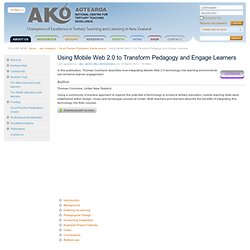
Both teachers and learners describe the benefits of integrating this technology into their courses. Introduction Blogs, wikis, podcasting, and a host of free, easy to use Web 2.0 social software provide opportunities for creating social constructivist learning environments focusing on student-centred learning and end-user content creation and sharing. Building on this foundation, mobile Web 2.0 has emerged as a viable teaching and learning environment, particularly with the advent of the iPhone (Nicknamed “the Jesus phone”) and iPod Touch.
This video outlines the potential of Wireless Mobile Devices (WMDs) and Web 2.0 (social software) to create social constructivist learning environments that bridge multiple learning contexts. Background Figure 1. Quality/2 - QualityOnTheLine.pdf.